As the two longest-running and best-selling brands in electric toothbrushes, it’s only natural to ask, when it comes to Oral-B vs. Sonicare—who wins?
We’ve reviewed the most popular models of both brands based on brush head design, cleaning method, features, price, and the science behind it all to compare these options.
Keep reading to find out how Oral-B and Sonicare differ and which is the best for your brushing needs. Check out our full guide to the best electric toothbrushes to learn about all of the best products on the market.
Our verdict is that:
• Oral-B is the best option overall for lower budgets and plaque removal
• Sonicare is best if you want a luxury option
While there are more studies that lean towards the cleaning power of oscillating motion — there are other studies that say sonic vibrations are better. But ultimately, both brands offer brushes that will do a great job cleaning your teeth, as long as you keep a proper oral hygiene routine.
Is Oral-B or Sonicare better?
Brush head design
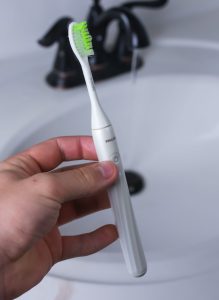

The Philips A3 Premium All-in-One brush head provides complete care for your teeth, mouth and gums. It features angled bristles with a curved profile and triangular tips that remove up to 20x more plaque and 100% more stains than a manual toothbrush.
Gum health improves up to 15x than it would with a manual brush. These heads also feature a blue color that fades away when its time to switch heads.
Oral-B heads are typically round, creating a cup covering each tooth during brushing. Depending on the head, the bristles might come out perpendicularly or at an angle — especially beneficial for getting plaque out of small spaces.
Brush heads are interchangeable for all Oral-B brushes except the iO series, for which you must purchase special heads.
Philips Sonicare toothbrushes have a more or less traditional brush shape. All of them are elongated and slightly smaller than that of a standard manual brush. There are different models with designs for various functions like gum care or whitening, but every head has a pattern with at least two types of bristles.
All their brush heads share that the bristles come perpendicular out of the head and can be used interchangeably.
Cleaning technology
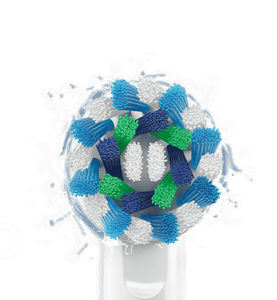

The toothbrushes in the iO range combine the iconic Oral-B oscillating action with micro-vibrations for the best of both worlds when it comes to the oscillating vs sonicare debate. What’s more, some studies have shown that the iO is more successful in improving gum health, and that there is a ‘small but significant‘ difference in the ability of the iO vs Sonicare when it comes to plaque control and gingival health.
Oral-B heads move in a spinning motion. Though the speed varies from model to model, Oral-B clocks its top-tier brushes at 8,800 oscillations per minute. Oral-B refers to its brush head oscillation as a “2D cleaning action”.
Many of their brushes (though not all) currently employ “3D action”, which combines the rotation of the head with a back-and-forth pulsing motion.
Oral-B 3D toothbrushes have been shown to be more effective in plaque removal from the gumline, thus aiding in the improvement of gum health. Though it isn’t exactly the same as sonic vibration, it supposedly does some of the same fluid-dynamics-based indirect cleaning. You can find out more about specific Oral-B brushes in our review of the best Oral-B electric toothbrush.
The motion of a Sonicare toothbrush is known as “sonic vibration,” which is created by a high-powered motor in the handle. This motor emits a frequency that causes the bristles of the brush to move from side to side about 31,000 times per minute.
The high-frequency vibration is meant to loosen dental plaque and tartar from your teeth through contact and also indirectly through fluid dynamics. Depending on who you ask, this may remove anywhere from three to ten times as much plaque as a manual brush. For more information, you can check out our Philips Sonicare toothbrush review.
Noise level
The Philips Sonicare 4100 Power Toothbrush has a quiet hum that measures at around 60 dB, where as the quietist Oral-B brush (iO) measures at around 72 dB.
Oral-B toothbrushes are not known for their silent brushing — the oscillating motion of the head, along with the back and forth action of the 3D action brushes, makes quite a racket when compared to the softer hum of sonic brushes.
That being said, the newer iO9 series is designed with a different motor that is much quieter (2-12 decibels quieter) than other Oral-B brushes.
Sonicare brushes, as well as any other electric toothbrush that uses sonic vibrations, are going to be much quieter than the Oral-B.
Sonicare 9900 Prestige vs Oral-B iO
Now let’s compare the respective top-of-the-line brush from each brand — the Sonicare 9900 Prestige versus Oral-B’s iO Series 9.
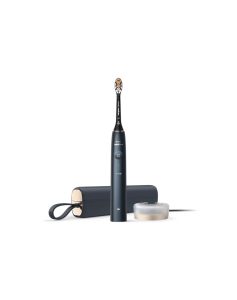

Both of these brushes offer the latest in features and connectivity from each brand. They also have a pretty high asking price but promise an unprecedented level of personalized cleaning. So, how do they compare?
Design
The Sonicare 9900 Prestige has a luxurious look and feel, with a sleek design and elegant color finishes — pink, champagne, or midnight blue — and metallic detailing. It has a simple on and off switch, and an illuminated battery icon indicator, a brush head replacement reminder, and smooth touch control.
The Oral-B iO comes in blue, pink, white, and black, though brush heads only come in black or white. The design is updated from previous Oral-B models, with smoother contours and a light-up touch display screen.
Cleaning
The Prestige uses 62,000 brush movements per minute (sonic vibrations) to break up and remove plaque. It has five customizable modes — clean, white, gum health, deep clean, and sensitive.
The iO uses micro-vibrations and oscillating/rotating movements for an optimal clean. It has seven brushing modes — daily clean, whiten gum care, sensitive, super sensitive, intense, and tongue clean.
Price
The Prestige 9900 has a suggested retail price of around $350, although you can often find discounts on the Sonicare website.
The Oral-B iO9 Series costs $299.99, and there are payment plans available.
Features
The Sonicare features:
- Pressure sensor: Lets you know when you are brushing too hard
- Position sensor: Lets you know where you are brushing for each brushing session
- Scrubbing sensor: Lets you know when you should reduce scrubbing, which is harmful to enamel
- 3D mouth map: This highlights areas you are missing when brushing
- Adaptive intensity: A feature that automatically adjusts the intensity level while you brush
- Artificial intelligence: SenseIQ technology senses the pressure, coverage, and motion of your brushing and automatically adapts brushing intensity. It also remembers your brushing mode and adjusts as needed
- Timer: Quad timer and 2-minute timer
- App connectivity: Compatible with the Sonicare app
See how the Sonicare Prestige 9900 works:
The iO features:
- Smart pressure sensor: Glows red when you brush too hard, white when it’s too light, and green when the pressure is perfect
- Interactive color display: Indicates mode setting, charging, and timer
- Artificial intelligence: A.I. Brushing Recognition and 3D Teeth Tracking provide real-time feedback so you can improve your brushing in the moment
- Magnetic charger: Charges in just 3 hours
- Travel case: Charge your toothbrush on the go with the travel charging case
- Bluetooth app: Track and personalize your brushing habits
Catch the iO 9 in action in the video below:
Oral-B vs. Sonicare study
There have been lots of studies specifically focused on the Braun Oral-B vs. Philips Sonicare question. After looking through them, we’ve come to the conclusion that Oral-B may be slightly more efficient at removing plaque, but that’s not to say that Sonicare doesn’t make an outstanding brush.
Additionally, while some studies say Oral-B is the better brush, in others, Sonicare is the winner. Below we’ve put together a few excerpts from several of these studies to give you an idea of what researchers are saying regarding this debate:
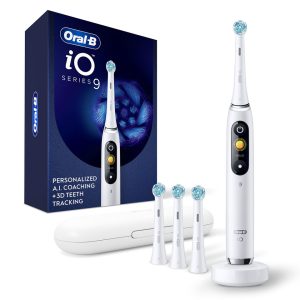

Research results
This study from the International Journal of Dental Hygiene found a significant difference between the efficacy of an oscillating toothbrush vs a sonic toothbrush head — the oscillating toothbrush coming out on top.
But yet another study found that while both brushes were helpful in improving subjects’ oral hygiene, Philips Sonicare had a clear advantage over Oral-B:
“Overall, this study demonstrates that long-term use of these two electric toothbrushes improves periodontal health in adult periodontitis patients, and that the Sonicare brush is superior to the Braun brush in reducing gingival inflammation and probing depth. Moreover, 6 months’ use of Sonicare led to actual improvement in probing attachment levels of periodontal pockets.”
-Robinson, Madalozzo, and Breslin
Meanwhile, these researchers concluded that Oral-B’s rotational toothbrush head motion was more effective versus Sonicare’s sonic vibration:
“Based on the findings of this single-use clinical evaluation, the action of the oscillating/pulsating power toothbrush is more effective at plaque removal than a high-frequency power toothbrush.”
-Strate et al.
Another study observed that the Philips Sonicare brush was significantly better than Oral-B:
“In this randomized single-use clinical study, both the Philips Sonicare FlexCare and the Oral-B Triumph Professional Care9000 power toothbrushes were safe and effective. FlexCare reduced plaque scores significantly better than Triumph.”
-Putt et al.
Finally, this analysis found that there was no significant difference at all in the performance of the two brushes. Interestingly enough, the Oral-B electric toothbrush users in this study were more likely to continue to use the brush in the future versus the Sonicare users, despite equal cleaning results.
After 8 weeks use, there was found to be no statistically significant difference in either plaque removal or gingival index between the two groups. Both devices were found to be safe, but whereas 100% of volunteers in the Braun Oral-B Plaque Remover group expressed a wish to continue using the toothbrush, approximately 25% of the Sonicare group did not like the device…
-Grossman, Debling, and Proskin
The takeaway? There’s no real proof that one is much better than the other. We gave you our top pick at the top of the article, but that doesn’t mean that we don’t like both toothbrushes.
The reality is that both brands will do a great job keeping your teeth clean — in fact, as long as you use the right technique, a manual brush will too — just not quite to the extent as an electric toothbrush, which we will talk about more now.
Electric vs manual
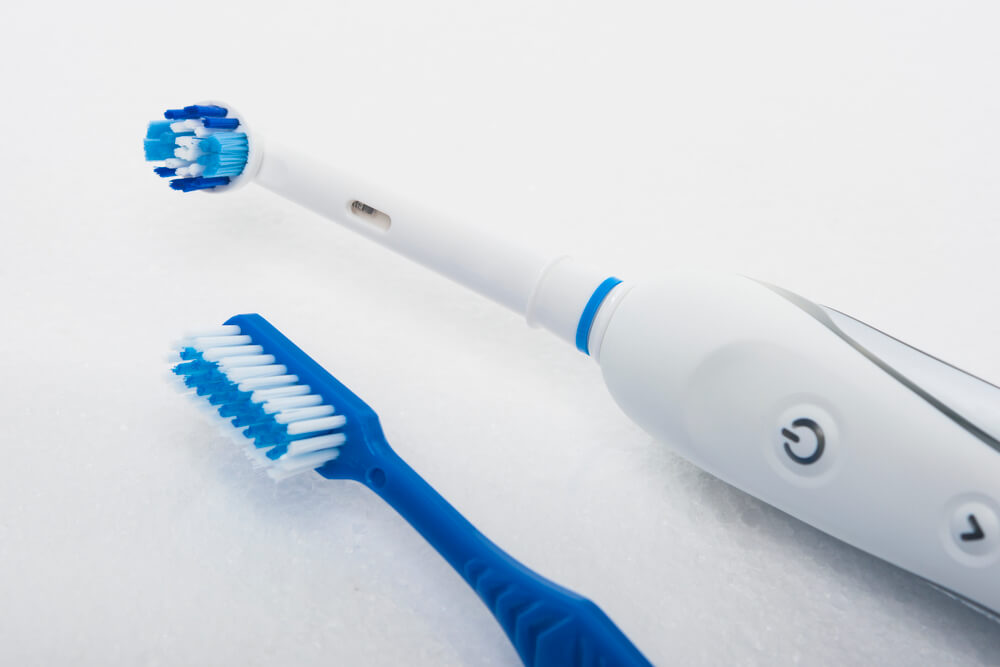

If the effectiveness of electric toothbrushes was the same as that of manual brushing, it would certainly be difficult to justify spending hundreds of dollars on an electric toothbrush. That’s why there have been various studies carried out to find out the difference, and the consensus is that electric toothbrushes are more effective at cleaning your teeth than manual ones.
A recent study from the International Journal of Dental Hygiene has found that there is “high certainty” that an electric toothbrush is more effective than a manual toothbrush at removing plaque, supporting the use of a powered toothbrush.
Another study from 2013 found that “when compared with a manual toothbrush, a powered toothbrush has the potential to improve oral hygiene by achieving plaque reduction.” This is not the only study to produce such findings, but the reason that electric toothbrushes are more effective may not be what you think.
According to the ADA, powered toothbrushes are most helpful to people with limited dexterity because of age or disability or people who have dental appliances. This is because the movement of the brush head provides good brushing technique everywhere that it reaches, while manual brushing can be suboptimal in hard-to-reach areas or difficult for some people.
The advantage of electric toothbrushes isn’t that they do what manual brushes cannot. Rather, they make it much easier and more efficient for users to properly clean every part of the mouth.
Oral-B and Sonicare alternative
If you’re not convinced by Oral-B or Sonicare, you may want to consider giving the CariPRO Ultrasonic a try. When it comes to maximizing the health of your smile, it doesn’t really get better than this. Plus, the mid-range price of $119 makes it much more accessible than some of the top-range models of other electric brushes.
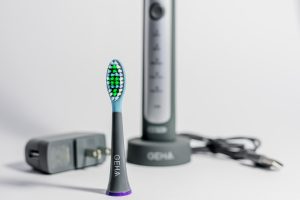

Just some of the features of this brush include:
- 40,000 vibrations/minute
- 5 brush modes—clean, white massage, gum care, and sensitive
- 30-day battery life on a single charge
- Ergonomic slim design
- Waterproof
- Smart timer
- Wireless charging dock
What’s more, there’s a 60-day trial period, so if you don’t love it by the end of the 60 days, you can get a full refund! Try it out by clicking the button below. You can also find out more about the CariPRO in our separate CariPRO review.
Conclusion
To sum up, Oral-B and Sonicare both have pros and cons at all price ranges and neither one has a clear overall advantage over the other. Studies do show that either will be more effective than a manual brush. In a “Sonicare vs. Oral-B” scenario, there is less agreement.
That said, anyone trying to decide between the two simply has to ask which features and characteristics are most important in order to find the best choice for them.
For example, someone who likes the idea of both oscillating and pulsating motion in their brush will definitely prefer Oral-B’s 3D cleaning action. On the other hand, someone who is interested in a quieter motor and modern design should probably shop for a Sonicare.
If after reading this review, you feel like you want to go in the other direction — an electric toothbrush that brushes effectively but has a minimalist design without all of the frills, you can read our Mode toothbrush review or our Brüush review.
Ultimately, the best thing you can do for your oral hygiene is to maintain a regular brushing and flossing schedule, regardless of which type of toothbrush you use.
FAQs
Is Oral-B or Sonicare better?
More studies have found that oscillating brushes remove more plaque than sonic vibrations. But there are also studies available that argue the opposite, as well as dentists on both sides.
Do dentists recommend Oral-B or Sonicare?
Some dentists recommend Oral-B and some Sonicare. That being said, it is more typical to see Oral-B brushes in a dentist’s office, but that’s probably because of an affiliation with the brand.
National Center for Biotechnology Information: A comparison of the efficacy of powered and manual toothbrushes in controlling plaque and gingivitis: A clinical study. [1] Consulted September 16, 2020
ADA: Toothbrushes. Consulted September 16, 2020
National Center for Biotechnology Information: A six-month clinical comparison of the efficacy of the Sonicare and the Braun Oral-B electric toothbrushes on improving periodontal health in adult periodontitis patients. Consulted 16th September 2020
ResearchGate: A comparison of the plaque removal efficacy of two power toothbrushes: Oral‐B Professional Care Series versus Sonicare Elite. Consulted September 16, 2020
ResearchGate: A randomized, crossover-design study to investigate the plaque removal efficacy of two power toothbrushes: Philips Sonicare FlexCare and Oral-B Triumph. Consulted September 16, 2020
International Journal of Dental Hygiene: The efficacy of an oscillating-rotating power toothbrush compared to a high-frequency sonic power toothbrush on parameters of dental plaque and gingival inflammation: A systematic review and meta-analysis. Consulted 22nd May 2023.
American Journal of Dentistry: A 6-month randomized controlled trial evaluating a novel smart-connected oscillating-rotating toothbrush versus a smart-connected sonic toothbrush for the reduction of plaque and gingivitis. Consulted 22nd May 2023.
National Center for Biotechnology Information: A comparative clinical investigation of the safety and efficacy of an oscillating/rotating electric toothbrush and a sonic toothbrush. Consulted September 16, 2020
International Journal of Dental Hygiene: The efficacy of powered toothbrushes :-A Systematic Review and Network Meta-Analysis-. Consulted 12th December 2021.
National Center for Biotechnology Information: A comparison of the efficacy of powered and manual toothbrushes in controlling plaque and gingivitis: A clinical study. [1] Consulted September 16, 2020
ADA: Toothbrushes. Consulted September 16, 2020
National Center for Biotechnology Information: A six-month clinical comparison of the efficacy of the Sonicare and the Braun Oral-B electric toothbrushes on improving periodontal health in adult periodontitis patients. Consulted 16th September 2020
ResearchGate: A comparison of the plaque removal efficacy of two power toothbrushes: Oral‐B Professional Care Series versus Sonicare Elite. Consulted September 16, 2020
ResearchGate: A randomized, crossover-design study to investigate the plaque removal efficacy of two power toothbrushes: Philips Sonicare FlexCare and Oral-B Triumph. Consulted September 16, 2020
International Journal of Dental Hygiene: The efficacy of an oscillating-rotating power toothbrush compared to a high-frequency sonic power toothbrush on parameters of dental plaque and gingival inflammation: A systematic review and meta-analysis. Consulted 22nd May 2023.
American Journal of Dentistry: A 6-month randomized controlled trial evaluating a novel smart-connected oscillating-rotating toothbrush versus a smart-connected sonic toothbrush for the reduction of plaque and gingivitis. Consulted 22nd May 2023.
National Center for Biotechnology Information: A comparative clinical investigation of the safety and efficacy of an oscillating/rotating electric toothbrush and a sonic toothbrush. Consulted September 16, 2020
International Journal of Dental Hygiene: The efficacy of powered toothbrushes :-A Systematic Review and Network Meta-Analysis-. Consulted 12th December 2021.




